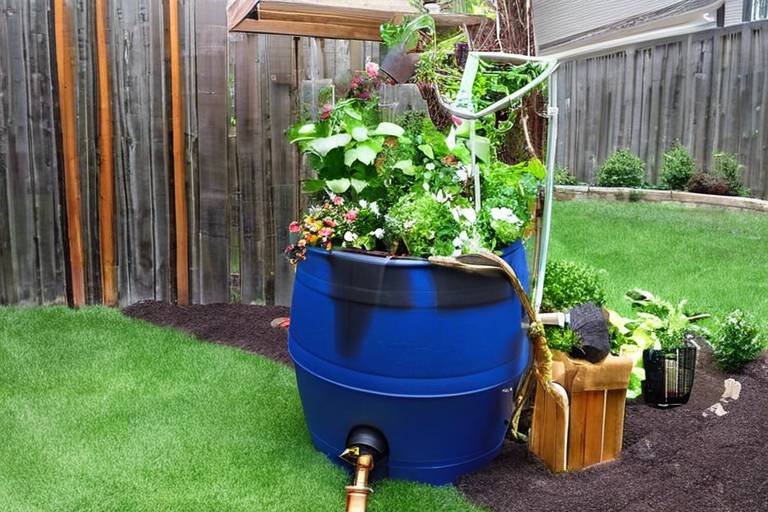How to Set Up a Rainwater Collection System for Your Garden
Setting up a rainwater collection system for your garden can be a rewarding and eco-friendly way to ensure your plants receive the hydration they need while also reducing your environmental impact. By harnessing the power of nature, you can create a sustainable water source that benefits both your garden and the planet.
When it comes to the benefits of rainwater collection, the advantages are plentiful. Rainwater is free from chemicals, making it ideal for watering plants as it provides essential nutrients without any harmful additives. Additionally, using rainwater reduces your reliance on municipal water sources, conserving this precious resource for other uses. By collecting rainwater, you can also help prevent soil erosion and reduce runoff, contributing to a healthier ecosystem.
Choosing the right collection system is crucial to ensure optimal performance. There are various types of rainwater collection systems available, including rain barrels, cisterns, and rain gardens. Consider factors such as the size of your garden, average rainfall in your area, and available space when selecting the system that best fits your needs.
The installation process of a rainwater collection system may seem daunting, but with the right guidance, it can be a straightforward task. Begin by determining the ideal placement for your system, ensuring it is close to downspouts and easily accessible. Gather the necessary materials, such as a collection container, filter, and overflow mechanism, and follow a step-by-step guide to set up your system effectively.
Calculating your water needs is essential to determine the size of the rainwater collection system required for your garden. Consider factors such as the size of your garden, types of plants, and average water consumption to ensure you have an adequate supply of rainwater to meet your irrigation needs.
Harvesting and storing rainwater efficiently involves proper filtration and storage techniques. Install a filter to remove debris and contaminants from collected rainwater, and use a storage container with a tight lid to prevent evaporation and contamination. Regularly check and clean your system to maintain water quality and ensure optimal performance.
Maintaining your rainwater collection system is key to its longevity and effectiveness. Establish a routine for cleaning the system, inspecting for leaks or damage, and performing necessary repairs. In colder months, winterize your system to prevent freezing and damage, ensuring it remains functional year-round.
Before setting up a rainwater collection system, be sure to consider any legal considerations in your area. Some regions have regulations or permits required for installing such systems, so it's important to research and comply with local laws to avoid any potential issues.
Once your rainwater collection system is in place, explore creative ways to use harvested rainwater in your garden. From watering plants and vegetables to cleaning gardening tools and outdoor surfaces, rainwater can be a versatile and sustainable resource for various eco-friendly practices.

Benefits of Rainwater Collection
When it comes to gardening, utilizing a rainwater collection system can offer a plethora of benefits that not only benefit your plants but also contribute positively to the environment. Imagine having a free and natural water source right at your fingertips, ready to nourish your garden whenever it's needed. The advantages of rainwater collection go beyond just cost savings; it's a sustainable practice that can elevate the health and vitality of your garden.
One of the primary benefits of rainwater collection is its purity. Rainwater is naturally soft and free from the chemicals and additives often found in tap water. This purity makes it an ideal choice for watering plants, as it allows for better absorption of nutrients and minerals from the soil, promoting healthier growth and blooming.
Moreover, rainwater harvesting reduces your reliance on municipal water sources, which can be treated with chlorine and other chemicals harmful to plants and the environment. By using rainwater in your garden, you are not only conserving water but also reducing the demand for treated water, thus contributing to water conservation efforts in your community.
Another significant advantage of rainwater collection is its eco-friendly nature. By capturing rainwater that would otherwise run off into storm drains, you are helping to reduce erosion and pollution in local waterways. Additionally, using rainwater in your garden decreases the need for energy-intensive water treatment processes, further lowering your carbon footprint.
Furthermore, rainwater is at its purest form when it falls from the sky, making it an excellent choice for sensitive plants that may be negatively impacted by the chemicals present in tap water. By incorporating a rainwater collection system into your gardening routine, you are providing your plants with a natural and gentle watering solution that promotes their overall well-being.

Choosing the Right Collection System
When it comes to choosing the right rainwater collection system for your garden, several factors need to be considered to ensure optimal efficiency and functionality. The first step is to assess the size of your garden and the amount of rainfall it typically receives. This information will help determine the capacity of the collection system needed to meet your watering needs.
There are various types of collection systems available, ranging from simple rain barrels to more complex underground storage tanks. Consider the space available in your garden for installation and the aesthetic appeal of the system. Additionally, think about the ease of maintenance and accessibility for regular checks and cleaning.
Another important factor to consider is the material of the collection system. Options include plastic, metal, and concrete tanks, each with its own advantages and disadvantages. Plastic tanks are lightweight and easy to install, while metal tanks are durable but may rust over time. Concrete tanks are sturdy but can be more challenging to install.
Furthermore, think about the filtration and purification methods incorporated into the system. Some systems come with built-in filters to remove debris and contaminants from the collected rainwater, ensuring it is safe for use in your garden. Consider the quality of the water needed for your plants and choose a system that meets those requirements.
Lastly, consider the cost and long-term sustainability of the collection system. While initial investment may vary depending on the type and size of the system, factor in the potential savings on water bills and the environmental benefits of using rainwater in your garden. Choose a system that aligns with your budget and sustainability goals.

Installation Process
Setting up a rainwater collection system in your garden can be a rewarding and environmentally friendly endeavor. The installation process involves several key steps to ensure efficient water harvesting for your plants. Firstly, you need to determine the ideal location for your collection system. Choose a spot that receives ample rainfall and is easily accessible for maintenance.
Next, gather the necessary materials for the installation, including a rain barrel or tank, downspout diverter kit, filter, and overflow hose. These components will help capture and store rainwater effectively. Ensure that your collection system is equipped with a secure lid to prevent debris and mosquitoes from entering.
Once you have all the materials ready, it's time to set up the collection system. Start by positioning the rain barrel or tank beneath a downspout to collect water runoff from your roof. Use a downspout diverter kit to direct water flow into the barrel and prevent overflow during heavy rainfall.
Consider elevating the rain barrel on a sturdy platform to increase water pressure when using it for irrigation. This elevation also allows for easy access to the spigot for filling watering cans or attaching a hose for direct watering.
Additionally, installing a filter at the entry point of the collection system helps remove debris and sediment from the rainwater, ensuring cleaner water for your garden. Regularly clean the filter to maintain optimal system performance.
Lastly, connect an overflow hose to redirect excess water away from the foundation of your home or garden. This prevents waterlogging and potential damage to structures. By following these installation steps, you can establish a functional rainwater collection system to support your garden's watering needs.

Calculating Water Needs
When setting up a rainwater collection system for your garden, one crucial aspect to consider is calculating the water needs of your plants. Determining the water requirements of your garden is essential to ensure that your rainwater collection system can adequately meet those needs. To start, you'll need to assess the size of your garden, the types of plants you have, and the average water consumption of those plants.
One method to calculate your water needs is to estimate the amount of water your garden requires on a weekly basis. Consider factors such as the climate in your area, the seasonality of your plants, and any specific watering requirements they may have. Additionally, take into account the frequency and duration of watering sessions to get a more accurate picture of your garden's water demands.
Another approach is to measure the square footage of your garden beds or planting areas. By knowing the surface area that needs watering, you can calculate the volume of water needed to adequately hydrate your plants. This method allows for a more precise estimation of your garden's water needs and helps in determining the size of the rainwater collection system required.
Moreover, consider the efficiency of your irrigation system and the water retention capacity of your soil. Efficient irrigation practices, such as drip irrigation or soaker hoses, can help reduce water wastage and optimize water usage in your garden. Additionally, soil that retains water well can lessen the frequency of watering, impacting the overall water requirements of your plants.
By accurately calculating your garden's water needs, you can ensure that your rainwater collection system is appropriately sized to provide sufficient water for your plants. This proactive approach not only helps in conserving water but also promotes healthy plant growth and sustainability in your garden.

Harvesting and Storing Rainwater
Harvesting and storing rainwater is a crucial step in setting up a rainwater collection system for your garden. When it rains, water is collected from various surfaces such as rooftops and directed into a storage container for later use. This process not only helps conserve water but also reduces your reliance on municipal water sources, benefiting both your garden and the environment.
One effective way to harvest rainwater is by installing a gutter system that directs the water into a downspout connected to a storage tank. The collected rainwater can then be filtered to remove debris and contaminants before being stored in a tank or barrel. Storing rainwater properly is essential to prevent evaporation and contamination, ensuring that the water remains clean and safe for use in your garden.
When storing rainwater, it is important to choose a container that is specifically designed for this purpose. Opt for a durable, UV-resistant tank or barrel that can hold the necessary volume of water for your garden's needs. Additionally, consider installing a cover or screen to prevent mosquitoes and other insects from breeding in the stored water.
Proper maintenance of your rainwater storage system is also key to ensuring the water quality remains high. Regularly check the container for leaks or damage, clean out any debris that may have accumulated, and consider installing a first flush diverter to divert the initial runoff that may contain contaminants away from the storage tank.
Utilizing a rainwater collection system not only helps you save money on water bills but also promotes sustainable gardening practices. By effectively harvesting and storing rainwater, you can ensure that your garden receives a consistent and eco-friendly water supply throughout the year.

Maintaining Your System
Maintaining your rainwater collection system is crucial to ensure its efficiency and longevity. Regular upkeep not only extends the life of the system but also helps in preserving the quality of the collected rainwater. One essential aspect of maintenance is regular cleaning of the system components. This includes removing debris from the gutters, checking and cleaning filters, and ensuring that the storage tanks are free from contaminants.
Inspecting the system for leaks is another vital maintenance task. Periodically check all connections, pipes, and tanks for any signs of leakage. Addressing leaks promptly can prevent water loss and potential damage to the system. Additionally, winterizing your rainwater collection system is essential, especially in colder climates. Properly draining the system and protecting it from freezing temperatures can prevent damage during winter months.
Consider creating a maintenance schedule to stay on top of regular upkeep tasks. Set reminders for cleaning, inspecting, and any necessary repairs to ensure that your rainwater collection system continues to function effectively. By staying proactive with maintenance, you can enjoy the benefits of using rainwater in your garden for years to come.

Legal Considerations
When setting up a rainwater collection system for your garden, it's crucial to consider the legal considerations surrounding this eco-friendly practice. While harvesting rainwater is generally encouraged for its environmental benefits, there may be local regulations or permits required in your area to ensure compliance with water usage laws.
Before embarking on your rainwater collection journey, it's advisable to check with your local authorities or water management department to understand any specific rules or restrictions that may apply. Some regions have guidelines on the size of the collection system, water usage limits, or restrictions on the use of rainwater for certain purposes.
Additionally, certain areas may require permits for installing rain barrels or larger collection tanks, especially if they are connected to the existing plumbing system. Understanding these legal requirements beforehand can save you from potential fines or penalties in the future.
It's essential to stay informed about the legal landscape regarding rainwater collection to ensure that your eco-friendly practices align with local regulations. By being proactive and seeking the necessary approvals, you can enjoy the benefits of using rainwater in your garden without any legal concerns.

Using Rainwater in Your Garden
Using rainwater in your garden is not only environmentally friendly but also beneficial for the health of your plants. By incorporating harvested rainwater into your gardening routine, you can make a positive impact on both your garden and the planet. There are various creative ways to utilize rainwater effectively, from watering your plants to cleaning your gardening tools.
One of the primary uses of rainwater in your garden is for watering your plants. Rainwater is naturally soft and free from the chemicals found in tap water, making it an ideal choice for watering your garden. Plants thrive on the nutrients present in rainwater, resulting in healthier and more vibrant growth. By using rainwater for irrigation, you can ensure that your plants receive the best possible care.
In addition to watering your plants, you can also use harvested rainwater for other purposes in your garden. For example, rainwater can be used for cleaning your gardening tools and equipment. Instead of using tap water, which may contain harsh chemicals, opt for rainwater to clean your tools effectively. This not only reduces your environmental impact but also helps maintain the longevity of your gardening equipment.
Furthermore, rainwater can be utilized for various eco-friendly practices in your garden. Consider setting up a rain barrel system to collect and store rainwater for future use. This stored rainwater can then be used during dry spells or droughts to ensure your plants receive an adequate water supply. By incorporating rainwater harvesting into your gardening routine, you can reduce your reliance on traditional water sources and promote sustainability.
Frequently Asked Questions
- What are the benefits of setting up a rainwater collection system for my garden?
Setting up a rainwater collection system can help you save money on water bills, reduce your environmental impact, and provide your plants with natural and chemical-free water.
- How do I choose the right rainwater collection system for my garden?
Consider factors such as your garden size, water needs, available space, and budget when selecting a rainwater collection system. Research different types like rain barrels, cisterns, or rain chains to find the best fit.
- What is the installation process like for a rainwater collection system?
The installation process involves choosing a suitable location, connecting the system to your downspout, ensuring proper filtration, and setting up overflow mechanisms to prevent flooding.
- How can I effectively harvest and store rainwater for later use?
Harvest rainwater by directing it from your roof into a collection system, filtering out debris, and storing it in a secure container to prevent contamination. Regularly check and maintain your storage system for optimal use.
- What legal considerations should I be aware of when setting up a rainwater collection system?
Check local regulations regarding rainwater harvesting, permits, and water rights to ensure compliance. Some areas may have restrictions on collecting and using rainwater, so it's essential to be informed.
- How can I use harvested rainwater in my garden effectively?
Utilize rainwater for watering plants, cleaning garden tools, filling birdbaths, or even washing your car. The eco-friendly practice of using rainwater can benefit both your garden and the environment.



















